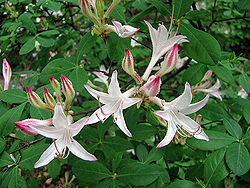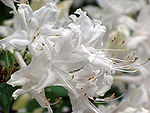Azalea
| Azalea |
|---|

|
| Scientific Classification |
|
| Species |
|
| Image Description |
Azalea are any of the species of ornamental flowering plants belonging to the taxonomic genus Rhododendron. The flowers, which bloom in spring, are large, colorful, and numerous, making it a popular member of flower gardens. Azalea means "dry" and was first coined in reference to these plants in the eighteenth century.[2]
Anatomy
There are several different types of both flower and leaf shapes for Azaleas. Ventricose-campanulate, flat saucer shaped, widely funnel shaped, openly funnel shaped, campanulate, openly campanulate, tubular, rotate, tubular funnel shaped and funnel shaped are the different types or shapes of the flower itself. The flowers come in all different colors. For leaves there are linear, oblong, obovate, orbicular, elliptic, ovate, lanceolate, and oblanceolate. [3]
There are only five lobes to the flower on Azaleas. They only have one stamen for each lobe. The Azalea usually has hair that grows parallel to the surface of the leaf, this is called oppressed hairs.[4]
Azaleas have three requirements, they need a constant supply of moisture, they must never sit in stagnant water (they might die), and they must be in an acid medium that is enough for the roots to have access to needed oxygen.[4]
Reproduction
For those who enjoy gardening Azaleas, not only can you let your Azalea reproduce naturally, but you can help them reproduce by five different techniques. These five techniques or ways of propagation is cuttings, grafting, layering, seed, or tissue culture.[5]
Cuttings is where you cut from the tip growth of the mother plant and plant the cuttings in the ground and have the cutting root. Dipping the cutting in a rooting hormone that has indolebutyric acid in it, will provide easier rooting. The rooting may take from six weeks to twelve months, sometimes not even at all. This form of propagation will cause the new growth to be identical to the mother plant.[6]
Grafting is where you take a cutting and cut the bottom of the cutting into a long "V" shape. Then the plant that is being used for understock, is cut so that there is a slit about the same length as the cutting with the v-shape. The slit can be placed at the tip of the limb (called top grafting) or in the side (called side grafting).[7]
Layering is a way to make the new plant identical to the parent plant. This is where a low limb of the plant is pulled down onto the ground, covered with loose soil and weighed down with a rock. This form of propagation takes at least a year to start to really grow.[8]
Tissue culture is taking a piece of tissue and placing it in a sterile petri dish with growth media (this process is not for the everyday gardener). With the use of agars and hormones (auxins, etc.), proper temperatures and light, and absolute sanitation, the piece of tissue is induced to mature into multiple seedling-like growths, but with no roots. Then the tiny plantlet is then rooted.[9]
Seeding is a sexual and natural reproduction rather than all of the above being vegetative propagation. As a result this plant will not be a clone. A seed is very tiny, as a result it requires a smooth fine surface in order to start growing. The seed usually takes any where from three to eight weeks, in some cases it might take longer to sprout.[10]
Ecology
There are insects and other pests that a gardener must watch for and get rid of to keep healthy Azaleas. These pests include; the root weevil, bark scale, aphids, leaf miners, caterpillars, leaf rollers, sawflies, spider mites, lacebugs, whiteflies, slugs, and snails. [11]
The root weevil tends to be a common problem with Azalea plant damage. The larvae does the most damage and it is impossible to see that damage is occurring until it is too late. The larvae eats the roots, as well as the cambium layer so the plant is unable to feed the top of the plant. The adult root weevils feed on the plant at night when it is fairly warm. To control these pests, one should spray Orthene on the foliage about every three weeks for about May to October, depending on the weather. [12]
When small insects that suck to feed on the bark, a sticky substance exudes and turns the stems black. This is called bark scale. In order to control use Orthene. [13]
Aphids (a sucking insect) feed on new foliage as it begins to grow, making the leaves to have distorted shapes. In order to control Aphids, use Malathion, Diazinon, or Orthene. [14]
Caterpillars, leaf rollers, and sawflies all chew on new foliage. They eat out large areas of new growth. Most of the damage is done to new growth. To kill use Orthene, Malathion, or Diazinon. [15]
The pest that causes the top of leaves to turn a brown-green color is the spider mite. They are a red color and are eight-legged. They suck on the bottom of the leaf, thus causing the discoloration. [16]
Lacebugs are small and have transparent wings. They suck on the bottom of leaves. The underside of the leaf will be a brown residue that has been exuded by the pest while on top of the leaf it turns to a gray-brown color. To remove lacebugs, use Orthene or Malathion. [17]
The whitefly looks like an aphid with wings. It leaves white spots at the locations where it has been. It sucks the underside of leaves. Use Malathion, Diazinon, or Orthene to exterminate. [18]
Slugs and Snails feed on flowers and new growth. Use Metaldehyde baits or sprays to control. [19]
Festivities
Just like there are Tulip festivals, there are Azalea festivals. The festivals usually happen in April.[20] [21]
Gallery
References
- ↑ USDA Author unknown, United States Department of Agriculture, Date accesed April 19, 2011.
- ↑ [1] Author unknown, Glam family, Date accessed May 7, 2011.
- ↑ Greer. "Greer's Guidebook to Available Rhododendrons third edition" Offshoot publications, 1996. (p.8).
- ↑ 4.0 4.1 Greer, p.9
- ↑ Greer, p.10
- ↑ Greer, p.10
- ↑ Greer, p.10
- ↑ Greer, p.10
- ↑ Greer, p.10
- ↑ Greer, p.10
- ↑ Greer, p.15-16
- ↑ Greer, p.15
- ↑ Greer, p.16
- ↑ Greer, p.16
- ↑ Greer, p.16
- ↑ Greer, p.16
- ↑ Greer, p.16
- ↑ Greer, p.16
- ↑ Greer, p.16
- ↑ Azalea Author Unknown, Oklahoma, Date Accessed May 7, 2011.
- ↑ [2] Author Unknown, North Carolina, Date Accessed, May 7, 2011.







